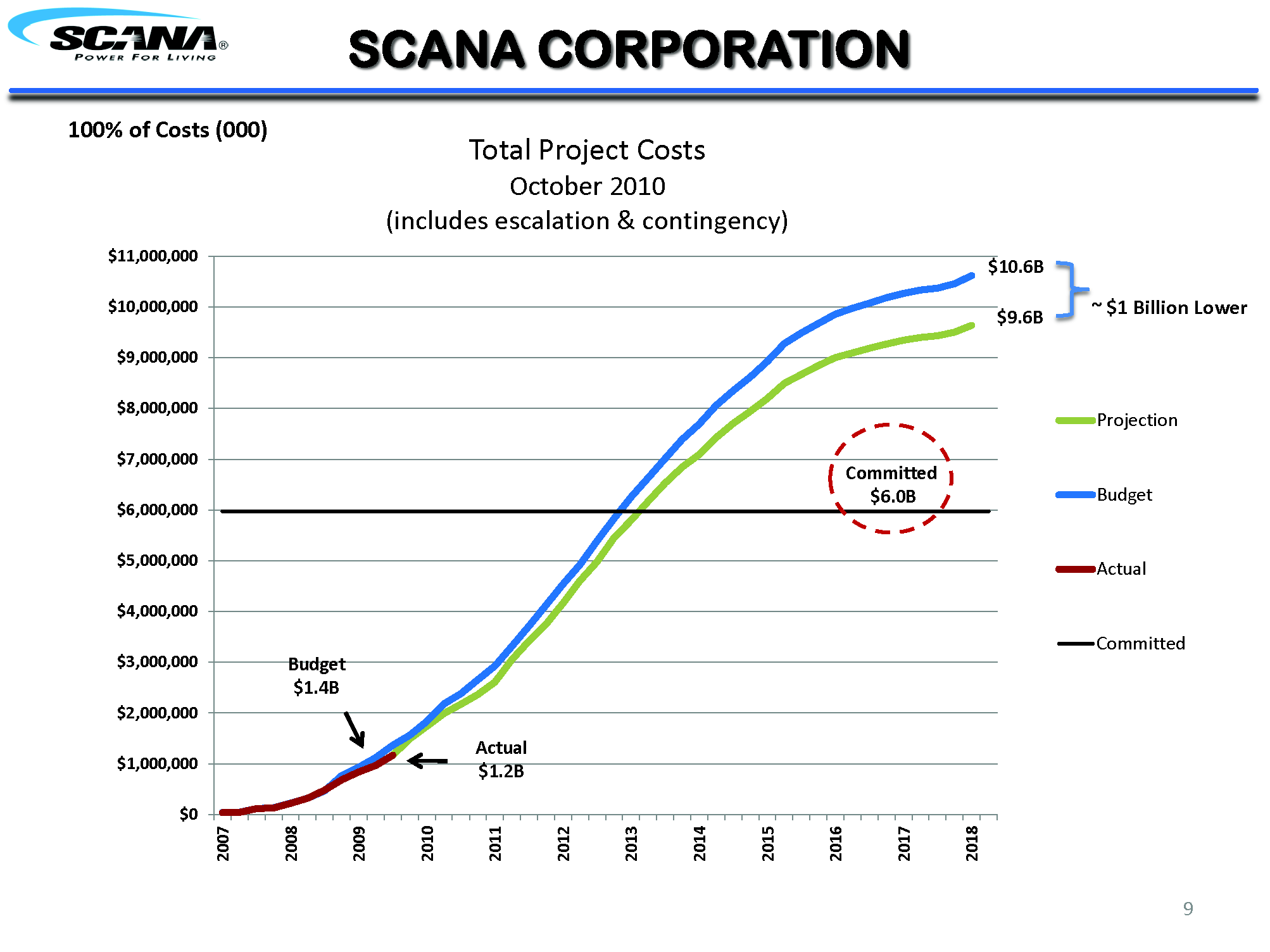Good progress report from South Carolina's new nuclear power plant
 A friend wrote me a nice note the other day that has brightened my outlook on the future of nuclear energy in the United States. Like many people who write about both the industry and the technology, I have been focusing on the complex story of nuclear loan guarantees. As an Annapolis, Md., resident and DC area worker, it was difficult to escape the frequently negative news coverage of the troubled Calvert Cliffs unit 3 project.
A friend wrote me a nice note the other day that has brightened my outlook on the future of nuclear energy in the United States. Like many people who write about both the industry and the technology, I have been focusing on the complex story of nuclear loan guarantees. As an Annapolis, Md., resident and DC area worker, it was difficult to escape the frequently negative news coverage of the troubled Calvert Cliffs unit 3 project.
The communication from my friend reminded me to look a bit further afield to a place that is less affected by the kind of groupthink that often occurs inside the Washington DC beltway and gets transmitted-a bit like a contagious disease-to its commuter communities. He sent me a link to SCANA's third quarter earnings report, which included a status report about the two-unit expansion project at the V. S. Summer Nuclear Station.
Here is the BLUF (bottom line up front). Note: that is a recent DC phrase to show you that I really was an inside-the-beltway kind of guy.
The Summer expansion project is on time, under budget, and shows excellent potential for keeping on that path. The first of the new units will be operating in 2016 and the second by 2019. The project leaders have stated that loan guarantee decisions made inside the beltway will not affect their schedule one way or the other. The estimated project total cost is $9.8 billion, which is less than $4500 per kilowatt of capacity. There is a good chance that the final number will be lower than that.
For all of the time that I spend on line, reading Google news alerts about new nuclear power plants, and talking with fellow nuclear professionals, all of those facts came as either news to me or as something that I might have heard in passing once and promptly forgotten. Major news outlets (Washington Post, New York Times, and Wall Street Journal) are not paying much attention to the success, possibly because it is happening in a relatively small state with only one company listed in the Fortune 500. That company happens to be SCANA, the holding company that owns South Carolina Electric and Gas (SCE&G) and is a 55 percent owner in the nuclear plant expansion project. Santee Cooper, a state-owned utility company, owns the other 45 percent of the project.
After I remembered that Santee Cooper was involved in the project, I recalled the only recent news story I have seen about V. C. Summer-it was a story that indicated that Santee Cooper was considering reducing its share of the project. Duke Energy and Progress Energy, both headquartered nearby in North Carolina, have expressed interest in talking with Santee Cooper about buying part of their stake in V. C. Summer. The Nuclear Information and Resource Service (NIRS), a professional antinuclear organization, put a negative spin on that story as just one more example of a company involved in new nuclear build getting cold feet.
The transcript of SCANA's third quarter earnings call, not surprisingly, gave a completely different perspective of the project's current progress. Among the financial jargon, it is possible to detect the enthusiasm of the people who are working hard to turn paper designs into two productive generating units that will help keep South Carolina's power prices among the lowest in the nation.
The transcript is a bit on the dry side and should be read with an understanding of the context of the situation-analysts and responders do not fully explain all of their questions or responses.
Kevin Marsh, president SCE&G (a SCANA subsidiary), introduced the discussion about the nuclear project, which is an important topic for the analysts that follow the company. Although it is the largest company in South Carolina, SCANA has a total market capitalization of just $5.2 billion, roughly equal to the total cost of its 55 percent share in the $9.8 billion project.
I would like to direct your attention to slide nine, which shows on a total project basis that the current projected nuclear plant construction cost, including estimated escalation, is approximately $1 billion under the forecasted final costs including in our initial BLRA filing from 2008. Additionally, you will note on the slide in the red dashed circle we have approximately $6 billion in the committed category projected to the total project cost of $9.6 billion.Click to Enlarge
(Note: the acronym BLRA means Base Load Review Act, which is the South Carolina state law covering the treatment of costs associated with the construction project.)
An analyst from Goldman Sachs started the question and answer session with a follow-up on V. C. Summer (aka, BLRA).
Michael Lapides (Goldman Sachs): Hi guys. Just a lot of moving parts regarding the BLRA and the Summer build. I just want to make sure I understand what are the basics. What are you now saying the cash cost of construction will be between today and the end of the project, and then the total cash costs all in?Jimmy Addison: (SCANA Corporation senior vice president and chief financial officer): We expect the total cost based on what we know today, including installation, would be $5.8 billion, the $5.896 on the second call which includes the AFUDC (Allowance for Funds Used During Construction).
The interesting part of that discussion is that the plant construction cost is only about 60 percent of the total project cost-much of the rest is due to the effects of inflation and interest cost during the 12 years between the budget projections and the project completion.
The transcript included hard questioning about various project risks and about the talk that Santee Cooper might want to reduce its share of the project. Though the language is a bit stilted and veiled, it is clear that the company believes that the project risks are falling due to low inflation and low interest rates. Company spokesmen also provided ample hints that they are not at all worried about finding a willing buyer for any portion of the project that Santee Cooper decides to sell. I expect that there have been any number of phone calls or private discussions that have given them some confidence.
There is little doubt that the good people headquartered in Columbia, S.C., are moving forward at a steady pace and that they have the project costs and schedule under their control. They are not waiting for inside the beltway bureaucrats at the Office of Management and Budget to produce a model that gives a reasonable credit subsidy cost computation. They have developed a financial model that works, keeps their analysts assured, and reassures their customers who are helping to pay for the project.
They are taking advantage of uncertainty in other projects to keep their borrowing costs low and their labor rates from going up. During the period since the project was announced, SCANA's stock price has varied and shown the effects of a major economic recession, but it is now trading for essentially the same $40 per share as it was before the company announced that it was going to invest billions into a new nuclear power plant.

Click to Enlarge
As a former resident of the great state of South Carolina, I fully expect that this story will end up something like the fable of the tortoise and the hare, with SCANA playing the role of the tortoise. The people who move forward at a steady pace and refuse to be tempted by fast burning attractions-like temporarily cheap natural gas-will succeed.
They will bequeath a valuable long-term productive asset to their children; which is always a great reason to face and overcome difficult challenges. That kind of thinking was hard to escape when I lived in Charleston, S.C., a place where leaving a legacy is a major motivator for any action.
Nuclear professionals should spread the story of this success around a bit. We need to do what we do best-learn lessons from "best practices" and share those lessons with others so that they can improve their own performance.

Adams
Rod Adams is a pro-nuclear advocate with extensive small nuclear plant operating experience. Adams is a former engineer officer, USS Von Steuben. He is founder of Adams Atomic Engines, Inc., and host and producer of The Atomic Show Podcast. Adams has been an ANS member since 2005 and is a regular contributor to the ANS Nuclear Cafe.

-3 2x1.jpg)
